The MacBook Pro Review (13 & 15-inch): 2011 Brings Sandy Bridge
by Anand Lal Shimpi, Brian Klug & Vivek Gowri on March 10, 2011 4:17 PM EST- Posted in
- Laptops
- Mac
- Apple
- Intel
- MacBook Pro
- Sandy Bridge
Improved WiFi Performance
One of the more notable changes in the 2011 MacBook Pro lineup is a completely different WiFi chipset and subsequent RF design. The previous 2010 MacBook Pro included 802.11a/b/g/n support using a BCM4322 which included full 2x2 MIMO support, meaning two spatial streams were supported. Bluetooth 3.0 was provided by a BCM2070, and the whole solution was simply a BCM954224HMB reference design.

2011 MacBook Pro WiFi+BT Module—Courtesy iFixit
Back when the new Airport Extreme (Simultaneous Dual-Band II) launched, it included one little-hyped feature. One of the most notable improvements over the previous design was inclusion of a full 3x3 radio—again 3 spatial stream support. At the time, there were no Apple products that could actually use 3 spatial streams, and as a result many assumed the feature was completely locked down.
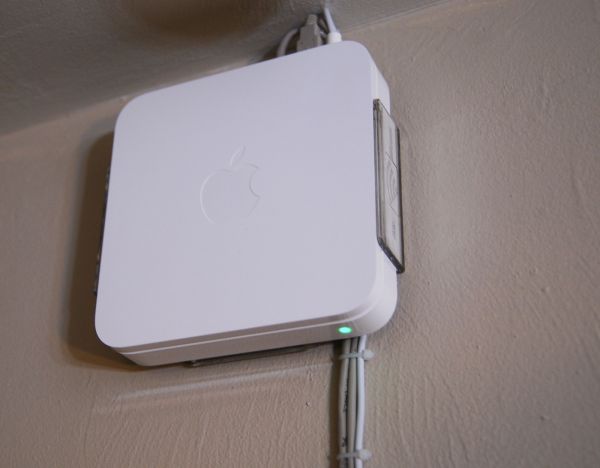
My wall-mounted Airport Extreme (Simultaneous Dual-Band II)
The Airport Extreme has had 3 spatial stream support for a long time to little fanfare. The Airport Extreme still only allows 20 MHz channels on 2.4 GHz spectrum. Other WiFi AP vendors ship firmware which will automaticaly selects 40 MHz channels on 2.4 GHz spectrum per WiFi Alliance rules, but Apple uniformly uses 20 MHz channels on 2.4 GHz. It's a design choice Apple made a while ago which still exists to this day – for two reasons. The first is that it prevents you from being, well, less than courteous and eating up to over 80% of spectrum on the already crowded 2.4 GHz ISM band with one AP. Apple's rationale for disabling 40 MHz channel support on the 2.4 GHz spectrum (for both clients and APs) is that Bluetooth needs lots of bandwidth to hop around on, and already a wide variety of Apple desktop and notebook products come by default with Bluetooth peripherals. Maintaining a good A2DP stereo stream for example requires considerable 2.4 GHz bandwidth. Instead, if you really want 40 MHz channels Apple recommends using 5 GHz, which Apple clients and Apple APs both allow to work with 40 MHz channels.
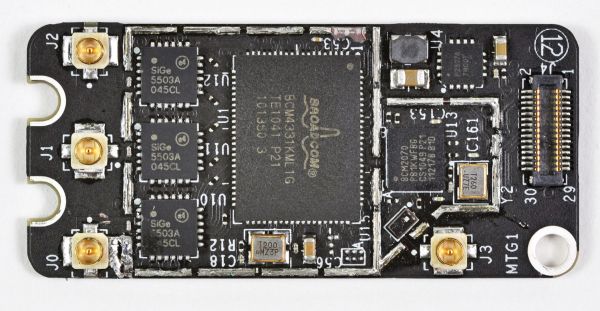
2011 MacBook Pro WiFi+BT Module—Courtesy iFixit
The 2011 MacBook Pro refresh is the first line of Apple products to bring 3x3 radios that can finally enable faster transfer rates and better performance at the edge of WiFi range. 3x3 MIMO support is starting to become relatively common in the PC notebook space, but this is the first for Apple. Inside the 2011 MacBook Pro is a BCM4331 and three clearly U.FL antenna connectors (on the left) for WiFi, as opposed to two in the previous design.
The fourth on the right is for Bluetooth, which remains 3.0 and provided by the same BCM2070 as previous models. Interestingly enough, though the Bluetooth controller is the same, the 2011 MacBook Pro includes newer firmware (37 vs 20), and software (2.4.3f1 vs 2.3.8f7). Hopefully at some point the older design will see a firmware update and bring whatever changes and improvements were made. Though the software versions are different, we couldn't detect any notable differences between the two in practice.

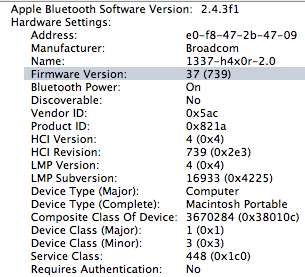
Left: 2010 MBP Bluetooth Hardware, Right: 2011 MBP Bluetooth
However, there's a dramatic improvement in both WiFi range and performance between the 2010 and 2011 refresh. With 400 ns guard intervals 40 MHz channels, 64-QAM modulation, each spatial stream adds n*150 Mbps. With 20 MHz channels, it's 72.2*n Mbps. For example, 1 spatial stream has a data rate of 150 Mbps, 2 has 300 Mbps, 3 has 450 Mbps, and so forth all the way up to 4 spatial streams and 600 Mbps as defined in the 802.11n specification. The reality of the matter is that what physical layer rate you'll see depends on the modulation and coding scheme and how many streams are going. You can look those up at any time by holding option and clicking the WiFi indicator, and looking them up in a table.
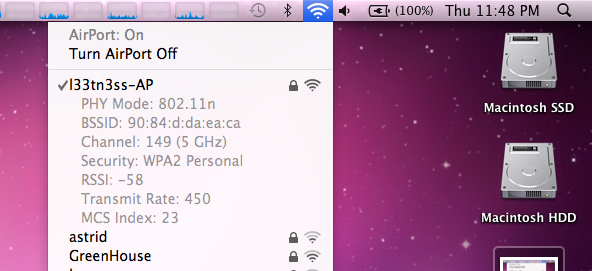
We tested a 15" 2011 MacBook Pro alongside a 15" 2010 MacBook pro connected to an Airport Extreme (Simultaneous Dual-Band II) running latest firmware. I originally suspected that 3 spatial stream support wasn't enabled, and that Apple would push a firmware update out right after their first 3 spatial stream products started shipping. Interestingly enough, it's always been there, enabled, this is just the first client I've gotten my hands on that does it. I'm not a huge fan of the Airport Extreme (I use a WRT54G-TM with Tomato and a WRT-600N with DD-WRT), but it's the only thing on hand with 3x3 MIMO. I tested in four different locations in my house—in my office, living room, kitchen, and outdoor patio. The base station is in my office mounted on the wall close to the ceiling, and those locations are subjectively ordered from best to worst.
To test, I initiated a large transfer over SMB (from a Windows Server 2008 R2 install with a 5 TB RAID5 array connected over gigabit ethernet) on each client, continually pinged AT, and at each location checked the reported transmit rate and RSSI. What we're reporting here is again the physical layer link. I'll show in a second that real-world transfers also improved, this just gives some perspective for what raw link rates are being negotiated at each location.
| WiFi Transfer Rate Differences—802.11n | ||||||||
| 2011 MacBook Pro | 2010 MacBook Pro | |||||||
| RSSI | Transfer Rate (Mbps) | RSSI | Transfer Rate (Mbps) | |||||
| Location 1—Office | -44 | 450 | -42 | 300 | ||||
| Location 2—Living Room | -61 | 130 | -64 | 117 | ||||
| Location 3—Kitchen | -69 | 117 | -68 | 78 | ||||
| Location 4—Outdoor Patio | -85 | 20 | -84 | 13 | ||||
In most cases, RSSI is within the margin of error. RSSI is generally not something you can compare, but since both wireless chipsets are Broadcom and the numbers are so close, it seems they're reported the same way and probably just dBm. Just know that generally it doesn't work that way unless you're lucky. What's important, however is that the negotiated link speed is noticeably better in essentially all locations on the new 2011 MBP. Even when the extra antenna isn't being used for a spatial stream of its own, it's actively improving link quality and helping the new MBP negotiate higher physical layer speeds.
So how much of a difference does 450 Mbps 3x3 make over 300 Mbps 2x2? With both in the exact same spot in my office, I saw throughput of 98.1 Mbps on the 2010 MBP compared to 113 Mbps on the 2011 MBP. The modest 15% improvement over the previous generation's wireless chipset isn't dramatic, instead the dramatically improved range is.
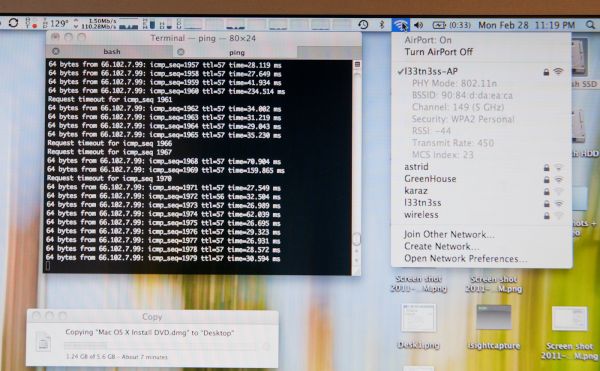 110.28 Megabits/s over WiFi. I later saw sustained 113 Megabits/s.
110.28 Megabits/s over WiFi. I later saw sustained 113 Megabits/s.
Subjectively, I found many more APs visible with the new MBP. I was able to cling onto my AP all the way out to the curb (just like smartphones) when connected on 2.4 GHz, something the old generation just couldn't do.
The only complaint I have about the new wireless chipset is that it seems to hunt around for what rate it wants negotiated. I saw a number of different MCS (modulation coding scheme) values with the 2011 MBP in the exact same place. Link rates from just below 300 Mbps all the way up to the expected 450. It seems to settle out at the expected 450 Mbps in the same room as the AP, it just takes a while, whereas other 2x2 stacks I've seen always lock onto 300 Mbps and stay there in the same room and position.










198 Comments
View All Comments
robco - Thursday, March 10, 2011 - link
I made the mistake of buying a 15" MBP eighteen months ago and am stuck with a machine that has mediocre graphics and overheats constantly. Don't buy the MBP if you actually use it on your lap. That being said, the only reason I bought it over the MacBook was the dedicated graphics. With the awful performance of the Intel integrated chip, I hope Apple releases a 15" MacBook with the option of dedicated graphics for consumers. I'm not shelling out $2199 just to get something with a decent video card. I wouldn't recommend the 13" at all, as there are several alternatives in the 13-14" range that offer dedicated cards.I fell victim to the hype and now I have a fairly recent machine that can barely handle SC2 and an iPhone that can't make phone calls. Don't make the same mistake. Most of the tasks you can do on a Mac you can do on a Windows PC. Unless you are actually a pro and need a pro-grade machine, don't waste your money. For those who can justify the expense, they are nice machines, but if you actually put them to work, be ready to set them on a cool surface or get a cooling pad. They run awfully hot.
KoolAidMan1 - Thursday, March 10, 2011 - link
My MBP from last year plays SC2 perfectly, above 60fps most of the time which is great. Same with Source games. People on Youtube have already uploaded video playing the Crysis 2 demo on the new MBPs and it looks great.Your machine is almost two years old. Be logical when complaining about performance. Just because your machine is slow doesn't mean that the new ones aren't screaming fast: http://www.pcmag.com/image_popup/0,1740,iid=287468...
The 13" MBP is also decent with the SB IGP. I've seen clips on YT of people playing games even on the slower Macbook Air and it looks good. IGPs have come a long way from where they were in 2009.
robco - Thursday, March 10, 2011 - link
I'm a little miffed that a machine that was so expensive has become outdated rather quickly. I paid a lot just to get dedicated graphics. I could have and should have paid less to get a Windows notebook. I won't make the same mistake again. If you're a consumer and don't need a pro-grade machine but still want good graphics, the MBP is a poor value.The MBA actually handles games better than the new 13" MBP because it still uses the C2D and the NV integrated chipset. Once it switches to Sandy Bridge, performance will drop as it has with the MBP. The only area the MBA is slower than the MBP is raw processing power, graphics and disk access are much faster.
With Apple you can get a notebook that performs well, you just have to shell out $2199 to get it. I did that once, I won't do it again. it just isn't worth it unless you're a pro user who will recoup that cost in a short time. For consumers, it's a waste of money.
ImSpartacus - Thursday, March 10, 2011 - link
If you only needed the graphics muscle, you should've gotten a Windows laptop.Macbooks are for more mobile-minded users. They are thin, strong and have excellent battery life.
If you just need a solid mobile workstation that isn't going to be moved a lot, Windows laptops are a much better value.
SimKill - Friday, March 11, 2011 - link
ODM manufacturers like Clevo and Compal fit your bill perfectly. I got my system in 2009 August and even today I can play most of the games (ofcourse except godforsaken Crysis) at high settings at 1680x1050 (yep, 16:10) It cost me around $1400 but I'm very happy about it so far.SimKill - Friday, March 11, 2011 - link
Dam, they don't have an edit button. The hardware internals are pretty good with copper heatsinks and heatpipes and what not too...erple2 - Friday, March 11, 2011 - link
Hrm. Mac's are more of a semi-pro-grade machine. They still lack some of the important pro-grade features of an actual pro-grade machine. Like a Docking Station. Or a spill-resistant keyboard. Or a thumbprint reader. Or a smart card slot. Or a high-gamut monitor.While they are well constructed, they still don't have some of the critical features required for a good business laptop - they lack the all important OpenGL performance GPUs for wireframe models (among other things). See some of the high end Elitebooks or Thinkpads (which also cost a bit more than these MacBook Pros).
tipoo - Thursday, March 10, 2011 - link
Ah, I just had a dumb, nevermind me.IntelUser2000 - Thursday, March 10, 2011 - link
http://www.anandtech.com/show/4205/the-macbook-pro..."This is a weird one, since the same GPU gave us significantly better performance in the SNB test system."
Oh gee, I wonder why. The SNB test system used quad core and the Core i5 2410M is a dual core. Quad vs. Dual does have some impact.
Anand Lal Shimpi - Thursday, March 10, 2011 - link
It does have some impact, but not in this case. The HD 3000 is actually GPU bound in those tests - not to mention that most games aren't quite so well threaded that 2 v 4 cores should matter.Take care,
Anand